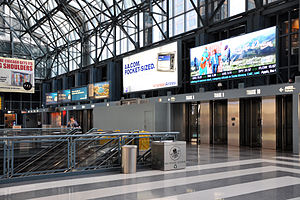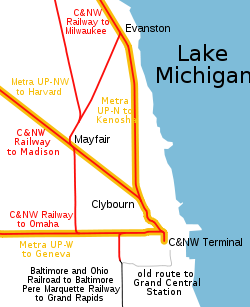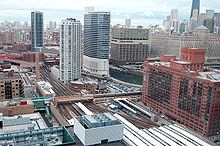- Ogilvie Transportation Center
-
Richard B. Ogilvie
Transportation Center
Station statistics Address 500 West Madison Street
Chicago, IL 60661Coordinates 41°52′58″N 87°38′25″W / 41.88269°N 87.64029°WCoordinates: 41°52′58″N 87°38′25″W / 41.88269°N 87.64029°W Lines Union Pacific/NorthwestConnections CTA "L" Lines: at Clinton 2 blocks North of Station
at Washington/Wells 3 blocks East of Station
CTA BusesPlatforms 8 island platforms Tracks 16 Other information Opened 1911-1912 Rebuilt 1984-1987 Accessible 
Owned by METRA Fare zone A Formerly Chicago and North Western Terminal
North Western StationTraffic Passengers () 41,000 daily (Metra)[1] Services Preceding station Metra Following station toward KenoshaUnion Pacific/North Terminus Union Pacific/Northwest Some weekday trainstoward ElburnUnion Pacific/West weekends, most weekday trainstoward ElburnThe Richard B. Ogilvie Transportation Center (
 /ˈoʊɡɨlviː/) is a passenger terminal in downtown Chicago, Illinois, USA, serving the three commuter rail lines of Metra's Union Pacific District, which approach the terminal elevated above street level. It occupies the lower floors of the Citigroup Center. The building occupies two square blocks, bounded by Randolph Street and Madison Street to the north and south and by Canal Street and Clinton Street to the east and west.
/ˈoʊɡɨlviː/) is a passenger terminal in downtown Chicago, Illinois, USA, serving the three commuter rail lines of Metra's Union Pacific District, which approach the terminal elevated above street level. It occupies the lower floors of the Citigroup Center. The building occupies two square blocks, bounded by Randolph Street and Madison Street to the north and south and by Canal Street and Clinton Street to the east and west.Contents
History
The 1911 station
The Chicago and North Western Railway built the Chicago and North Western Terminal in 1911 to replace its Wells Street Station across the North Branch of the Chicago River. The new station, in the Renaissance Revival style, was designed by Frost and Granger, also the architects for the 1903 LaSalle Street Station.[2]
The station's 16 tracks were elevated above street level and "reached by six approach tracks and sheltered under an 894-foot-long [272 meter] Bush train shed."[2] The upper level of the head house housed a concourse and other facilities for intercity passengers, including "dressing rooms, baths, nurses and matrons rooms, and a doctor's office."[3] The centerpiece of the upper level was a stately waiting room, measuring 34 by 62 meters (102 by 202 feet), and rising 26 meters (84 ft) to its barrel-vaulted ceiling.[2] In addition to the main concourse on the upper level, there was a street-level concourse for commuters.
During the heyday of rail travel, the Chicago and North Western Terminal was home to the C&NW's trains to Milwaukee, Minneapolis-St Paul, Madison and other cities of the upper Midwest, including the railroad's premier "400" series of trains. Until October 30, 1955, it was also the Chicago terminus of the trains the Union Pacific ran in conjunction with the C&NW, including the Overland Limited and the famed "City" trains. See below for some of the best known of the trains served by this station.
The 1984 station
In 1984 the 1911 head house was razed and replaced with the glass-and-steel 42-story Citicorp Center, which was completed three years later in 1987. The station was re-named the Ogilvie Transportation Center in 1997, two years after the C&NW merged into the Union Pacific Railroad. The station was named for Richard B. Ogilvie, a board member of the Milwaukee Road and a lifelong railroad proponent, who, as governor of Illinois, created the RTA, which is the parent agency of Metra. The station remains known colloquially as North Western Station or North Western Terminal.
1991 rehabilitation
In 1991 Metra purchased the train shed from Chicago and North Western and conducted a survey to determine the condition. The examination included necessary repairs needed to improve its structural integrity and redesign measures to bring the station up to modern mass commuting standards. After completing a thorough evaluation, Metra, the Urban Mass Transportation Administration, and the Illinois Department of Transportation decided to completely rehabilitate the structure and in 1992, with the assistance of Federal funding, a contractor and management team were selected to begin the work.
Many engineering challenges had to be addressed and resolved, not only because of the train shed’s prominent location but also due to its high traffic volume as it was to remain operational to 45,000 daily commutes during the project. Such challenges included the removal of original lead paint, the complete replacement of all 16 tracks (serving 200 trains a day), extensive structural steel repairs (under load), erection of a new steel canopy, complete exterior masonry restoration, new electrical and plumbing, and construction of a new pedestrian concourse. During the rehabilitation project, which lasted four years and cost $138 million, over 60 contractors spent more 800,000 man hours performing repairs and producing new construction.
Services
 Except from late 1969 to mid-1971, only the Chicago and North Western Railway used their terminal.
Except from late 1969 to mid-1971, only the Chicago and North Western Railway used their terminal.
The Chicago and North Western Terminal has served as a terminal for all the commuter and intercity trains of the Chicago and North Western Railway. In addition, on November 9, 1969, the day after Grand Central Station closed, the Baltimore and Ohio Railroad and Pere Marquette Railway, Grand Central's two remaining users, moved their remaining intercity services into the C&NW's terminal. Those trains, which used the C&NW's branch to the St. Charles Air Line west of Western Avenue, last ran on April 30, 1971, the day before Amtrak took over most intercity passenger trains in the U.S. Amtrak services over the lines of those two railroads have run into Union Station.
Metra's three Union Pacific District lines - the Union Pacific/North Line, Union Pacific/Northwest Line and Union Pacific/West Line - now provide regular commuter rail service along three former C&NW lines. In Metra's zone-based fare schedule, Ogilvie is in Zone A. Approximately 37,500 people board Metra trains at Ogilvie Transportation Center each day.[4]
Bus and 'L' connections
Bus connections can be made on Madison Street or Washington Boulevard via the Citigroup Center or through a lower level concourse accessible by the track platforms between Washington Boulevard and Randolph Street with entrances at Canal and Clinton Streets. Ogilvie is served by the Green and the Pink lines of the CTA's 'L' system, three blocks north of Madison Street on Clinton and Lake Streets; passengers can use the Washington/Randolph concourse exit to walk one and a half blocks to Clinton.
- #14 Jeffery Express
- #19 United Center Express
- #20 Madison (Owl Service)
- #56 Milwaukee
- #60 Blue Island/26th (Owl Service)
- #120 Ogilvie/Wacker Express
- #122 Illinois Center/Ogilvie Express
- #124 Navy Pier
- #125 Water Tower Express
- #126 Jackson
- #128 Soldier Field Express (Game Days / Major Concerts Only)
- #129 West Loop/South Loop
- #130 Museum Campus (Summer Service Only)
- #157 Streeterville/Taylor
- #192 University of Chicago Hospitals Express
Major trains of the pre-Amtrak era
- Chicago & North Western trains
- North Western Limited
- Twin Cities 400
- Flambeau 400
- Rochester 400
- Kate Shelley 400
- Dakota 400
- Union Pacific/Chicago & North Western trains
- Overland Limited
- City of San Francisco
- City of Los Angeles
- City of Portland
- City of Denver
- Gold Coast
See also
References
- ^ http://metrarail.com/metra/en/home/maps_schedules/downtown_chicagostations/ogilvie_transportation_center.html
- ^ a b c Holland, Kevin J. (2001). Classic American Railroad Terminals. Osceola, WI: MBI Publishing. pp. 82–83.
- ^ Maiken, Peter T. (1989). Night Trains. Baltimore, MA: Johns Hopkins University Press. p. 166.
- ^ On the Bi-Level, October 2007.
- Kevin P. Keefe, City of Six Stations, Trains July 2003, p. 69
External links
- Ogilvie Transportation Center (Metra)
- PRR Chronology
- main entrance (Madison Street) from Google Maps Street View
- Washington Boulevard entrance from Google Maps Street View
Metra Lines CurrentProposedNICTD ServiceStations and Terminals Rolling stock Accidents and incidents 1972 Chicago commuter rail crash · 1995 Fox River Grove bus–train collisionMajor inter-city railroad stations of Chicago Active terminals Former terminals Central Station · Dearborn · Grand Central · Central Depot · Galena and Chicago Union · Nickel Plate · Wells St. Station · Wells St. Terminal · Columbian ExpositionOther stations Categories:- Metra stations in Chicago, Illinois
- Stations along Chicago and North Western Railway lines
- Stations along Baltimore and Ohio Railroad lines
- Pere Marquette Railway
- Clock towers in the United States
- Transit centers in the United States
- Charles Sumner Frost buildings
Wikimedia Foundation. 2010.




